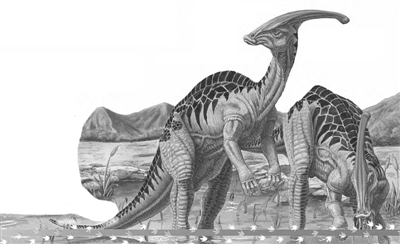(单词翻译:单击)
Sauroposeidon has a brain less than a thousandth of its body size-the equivalent of a human being with a brain the size of a pea.
波塞东龙的大脑不及身体体积的千分之一,就如同人类只有一个豌豆大小的大脑一样。
Lobes for both sight and smell are tiny.
掌管视觉和嗅觉的脑页非常小。
Areas controlling information analysis, learning, and complex thought are barely developed.
而控制分析信息,学习和复杂思考的区域几乎没有进化。
If you look at the size of their brain, you actually have to kind of wonder how these animals managed.
如果你们观察了它们大脑的尺寸,一定会很好奇这些动物是怎么活下来的。
But they did manage. Physical size makes up for every other shortcoming.
但它们确实活了下来。巨大的体型弥补了其他方面的不足。
Surviving for 15 million years,
这些庞然大物存活了一千五百万年,
these mammoth creatures spread out across the globe onto every continent except Antarctica.
足迹遍及全球各个大陆,除了南极大陆。

But there's a another dinosaur that dosen't rely on size. they use a even more unusual tricks to stay alive.
但还有种恐龙并不依赖巨大的体型。它们利用了更加罕见的技巧来保证种族的生存。
The most sophiscated communication system ever developed in the prehistoric world.
史前世界最精细最发达的通信系统。
It's one vegetarian that lacks any obvious weaponry.
这种食草恐龙缺少一切显著的武器。
A Parasaurolophus is a duckbill...named for its ducklike beak.
副栉龙属于鸭嘴龙科以其鸭嘴得名。
Weighing in at almost four tons, it's not tiny,
虽然四吨的体重并不算小,
but facing off against a seven-ton predator like a T. Rex would be suicide.
但是面对体重七吨的捕食者雷克斯霸王龙依然无异于自杀。
They have no fangs, no armor at all, no spikes or horns anywhere on the body.
它们没有利齿,完全没有甲壳身上也没有尖刺或者角。
They seem to be large, vulnerable targets.
它们看上去就是脆弱而庞大的活靶子。
Parasaurolophus range across a vast area - more than 100,000 square miles from Alberta, Canada, to New Mexico,
副栉龙种群分布广泛——超过十万平方英里,从加拿大的阿尔伯达到美国的新墨西哥,
a region with more than its share of vicious predators.
比恶毒的捕食者要广得多。
What has puzzled all of us is, how did they protect themselves?
令人不解的是,它们是如何自我保护的?
The most important clue to this mystery is buried inside their skull.
揭开这个秘密的重要线索就掩藏在它们的头骨之中。
Parasaurolophus has the biggest brain of all herbivores.
副栉龙有食草动物中最大的大脑。
And one part of that brain is abnormally large-the area responsible for hearing and interpreting sounds.
而且其中一部分异常巨大,这就是听觉以及声波转化的区域。
It's called the auditory cortex.
这被称为听觉皮层。
What was a surprise is the higher centers of their brain are very large and suggest that
令人惊奇的是大脑的高级中心非常巨大,
something very different is going on in Parasaurolophus and its kin than in most other of these plant-eating dinosaurs.
这意味着副栉龙和它的亲缘物种一定有一些非常独特的,与其它食草恐龙些与众不同的地方。
But how does an advanced auditory cortex help a Parasaurolophus defend itself against monster carnivores?
但是发达的听觉皮层是如何帮助副栉龙防御怪物般的食肉动物的呢?
First of all, its acute hearing can detect an approaching predator from kilometers away.
首先,敏锐的听觉远隔数公里就能探测到捕猎者的来袭。
Then most importantly, it can react, deploying an unusual weapon.
更重要的是,它可以反抗利用非同寻常的武器。
A distinctive sound that originates deep inside a strangely shaped head crest.
形状怪异的头冠所发出的奇怪声音。


